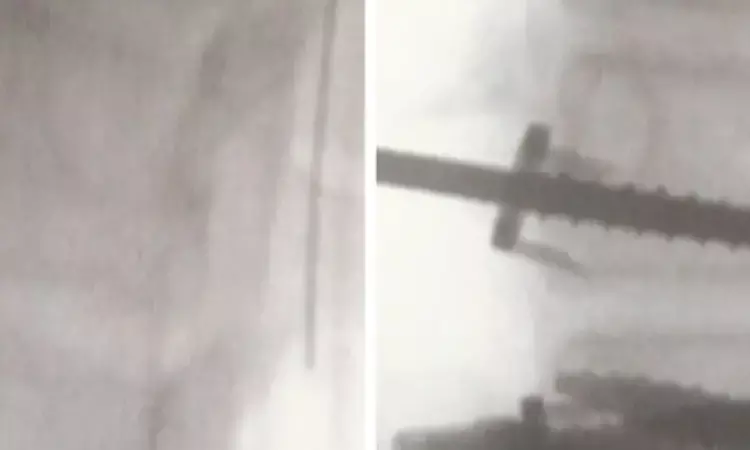- Home
- Medical news & Guidelines
- Anesthesiology
- Cardiology and CTVS
- Critical Care
- Dentistry
- Dermatology
- Diabetes and Endocrinology
- ENT
- Gastroenterology
- Medicine
- Nephrology
- Neurology
- Obstretics-Gynaecology
- Oncology
- Ophthalmology
- Orthopaedics
- Pediatrics-Neonatology
- Psychiatry
- Pulmonology
- Radiology
- Surgery
- Urology
- Laboratory Medicine
- Diet
- Nursing
- Paramedical
- Physiotherapy
- Health news
- Fact Check
- Bone Health Fact Check
- Brain Health Fact Check
- Cancer Related Fact Check
- Child Care Fact Check
- Dental and oral health fact check
- Diabetes and metabolic health fact check
- Diet and Nutrition Fact Check
- Eye and ENT Care Fact Check
- Fitness fact check
- Gut health fact check
- Heart health fact check
- Kidney health fact check
- Medical education fact check
- Men's health fact check
- Respiratory fact check
- Skin and hair care fact check
- Vaccine and Immunization fact check
- Women's health fact check
- AYUSH
- State News
- Andaman and Nicobar Islands
- Andhra Pradesh
- Arunachal Pradesh
- Assam
- Bihar
- Chandigarh
- Chattisgarh
- Dadra and Nagar Haveli
- Daman and Diu
- Delhi
- Goa
- Gujarat
- Haryana
- Himachal Pradesh
- Jammu & Kashmir
- Jharkhand
- Karnataka
- Kerala
- Ladakh
- Lakshadweep
- Madhya Pradesh
- Maharashtra
- Manipur
- Meghalaya
- Mizoram
- Nagaland
- Odisha
- Puducherry
- Punjab
- Rajasthan
- Sikkim
- Tamil Nadu
- Telangana
- Tripura
- Uttar Pradesh
- Uttrakhand
- West Bengal
- Medical Education
- Industry
Use of electronic conductivity devices effectively reduces radiation exposure in vertebral body tethering

Vertebral body tethering (VBT) is gaining popularity among spine surgeons for the treatment of selected AIS patients. It allows for maintenance of spine mobility, shorter recovery time and reduced adjacent segment degeneration. However, VBT comes with the disadvantage of an increased radiation exposure for the patient and the surgical staff, as the patient is positioned in lateral decubitus.
To reduce radiation exposure, the authors introduced the use of electronic conductivity device (ECD). These are drilling probes send an audio signal when cortical bone is breached. Thus, anterior, bicortical screws can be placed without multiple fluoroscopic controls.
Stephanie Da Paz et al conducted a study to test the safety of ECD and its efficacy in radiation reduction in comparison with the current standard, the fluoroscopic guidance. The article has been published in European Spine Journal.
All patients who underwent VBT were retrospectively reviewed and divided into two groups according to whether ECD had been used or not. All surgeries were performed by one author and the same fluoroscope was used for all surgeries. The radiation exposure per procedure and per screw was compared among the two groups, overall and separately for thoracic, lumbar and bilateral procedures. The rate of misplaced screws was calculated.
The authors commented - "Of note, the ECD cannot distinguish between the contralateral cortical breach or a possible breach in the cranial or caudal disk spaces or toward the spinal cord. Thus, even when using the ECD, AP and lateral X-rays are still required at the beginning of the threading to ensure that the trajectory is correct and runs parallel to the end plates. When the ECD gives the auditive signal that indicates the breach of the contralateral cortex, one more AP view is taken to confirm the correct trajectory and measure the length of the respective screw."
Key findings of the study were:
• Data from 62 patients and 825 screws were obtained (397 with ECD).
• No screw misplacement was observed.
• Radiation reduction with ECD reached up to 41%.
• A significant reduction was observed in the radiation per procedure in bilateral instrumentation (from 9.16 to 5.52 mGy*m2 ), and in the analysis per screw overall (from 9.16 to 5.52 mGy*m2 ) and for lumbar curves (from 0.54 to 0.32 mGy*m2 ).
The authors concluded that – “the present study shows that the use of ECD can effectively reduce the radiation exposure while maintaining the same level of safety achieved with the standard technique, namely the use of fluoroscopic guidance.”
Further reading:
The use of electronic conductivity devices can effectively reduce radiation exposure in vertebral body tethering
Stephanie Da Paz, Per Trobisch et al
European Spine Journal
https://doi.org/10.1007/s00586-022-07489-0
MBBS, Dip. Ortho, DNB ortho, MNAMS
Dr Supreeth D R (MBBS, Dip. Ortho, DNB ortho, MNAMS) is a practicing orthopedician with interest in medical research and publishing articles. He completed MBBS from mysore medical college, dip ortho from Trivandrum medical college and sec. DNB from Manipal Hospital, Bengaluru. He has expirence of 7years in the field of orthopedics. He has presented scientific papers & posters in various state, national and international conferences. His interest in writing articles lead the way to join medical dialogues. He can be contacted at editorial@medicaldialogues.in.
Dr Kamal Kant Kohli-MBBS, DTCD- a chest specialist with more than 30 years of practice and a flair for writing clinical articles, Dr Kamal Kant Kohli joined Medical Dialogues as a Chief Editor of Medical News. Besides writing articles, as an editor, he proofreads and verifies all the medical content published on Medical Dialogues including those coming from journals, studies,medical conferences,guidelines etc. Email: drkohli@medicaldialogues.in. Contact no. 011-43720751


